

|
|
|
|
|
Abbreviations used in this listing:
|
|
|
| Cape Rockjumper Chaetops frenatus * | E | The pair seen oh-so-well near Walker Bay (east of Cape Town) were the 'birds of the trip.' New biochemical research shows this group evolved near the base of the passerine tree of life and it is unrelated to anything else. They diverged from a common ancestor between Rockjumper and Rockfowl some 31 million years ago (Beresfordet al. 2005) |
| Clapper Lark Mirafra apiata * | E | Two birds studied and watched in flight during an evening drive at Anib Lodge (east of Mariental). Some authorities split Clapper Larks into 3 species but others do not. For the moment I consider them all the same species. If split these would have been "Eastern Clapper Lark M. fasciolata" |
| Fawn-coloured Lark Mirafra africanoides | A few encountered daily in the Kalahari desert (from KGNP to Mariental) | |
| Sabota Lark Mirafra sabota | NE | The common lark seen daily across northern Namibia (from Etosha NP to Caprivi Strip). It likes dry grasslands particularly. Enountered once in KGNP. |
| Cape Long-billed Lark Certhilauda curvirostris * | E | One watched calling in a foggy dawn in coastal scrub just south of Lamberts Bay. The loud upslurred whistle is characteristic of the Long-billed Lark complex. They were recently split into five species based primarily on biochemical evidence () but each taxa has quite a different bill length and shape. We saw 3 of the 5 on this trip; we had seen a fourth (Eastern Long-billed Lark C. semitorquatus) at Wakkerstroom some years earlier. |
| Karoo Long-billed Lark Certhilauda subcoronata * | E | Fairly common daily in the karoo around Brandvlei (up to 15/day) where the characteristic whistle carries for some distance; another near Fish River Canyon in Namibia. They call throughout the day from the tops of tall bushes or even telephone poles. |
| Benguela Long-billed Lark Certhilauda benguelensis * | E | Two seen after much effort in exceptionally dry and barren rocky hillsides near Uis in northwestern Namibia. We drove quite a distance out of our route to try for this third taxa in the Long-billed Lark complex. It was much paler and shorter-billed than the species farther south; consistent with the habitat. There are no known tapes of this bird but it responded reluctantly to the tape of Eastern Long-billed. When it called itself the quality of the whistle was noticeably different. |
| Karoo Lark Certhilauda albescens * | E | One bird was foraging in dunes at our feet in West Coast NP; another was in full song flight in wildflower-strewn karoo south of Calvinia. These were the only two we found. |
| Red Lark Certhilauda burra * | E/
VU |
My 'most-wanted' lark for the trip was found by driving dirt roads northeast and southwest of Brandvlei. At least a dozen were seen; several were in full skylarking song flights just after dawn. We were amused that the name of the little restaurant in our motel was the "Red Lark Cafe" and that it featured a wall mural showing this endemic bird. |
| Spike-heeled Lark Chersomanes albofasciata | NE | Rather common in the karoo around Brandvlei (up to 18/day); seen later at Anib Lodge and regularly again in Etosha NP (8-18/day) where we also had adults with juvenals |
| Chestnut-backed Sparrowlark Eremopterix leucotis * | A half-dozen or so males were among huge flocks of Gray-backed Sparrowlarks coming to drink at Okaukuejo waterhole in Etosha one evening. They were 'scoped from our 'bleacher' seats | |
| Grey-backed Sparrowlark Eremopterix verticalis * | NE | Huge swirling flocks of hundreds of birds were alongside and on the roads in southern Namibia (many were hit by cars; we did our best to miss them but they would often sit on the pavement of a fast road until the last second). Huge flocks visited waterholes in Etosha NP as well. In South Africa we had only a handful on the drive to Augrabies Falls NP |
| Red-capped Lark Calandrella cinerea | A very few seen or heard in KGNP; then big numbers (~75) on one day in Etosha | |
| Sclater's Lark Spizocorys sclateri * | E/
NT |
Hard work and lots of stopping in arid spots around Brandvlei finally yielded scope views of two of these tiny larks |
| Stark's Lark Eremalauda starki * | NE | These inhabitants of extremely barren dry plains were seen near Spitzkoppe and the next day near Uis |
| Thick-billed Lark Galerida magnirostris * | E | A dozen or so were at Tienie Versveld Wildflower Reserve; a handful more were in the karoo around Brandvlei |
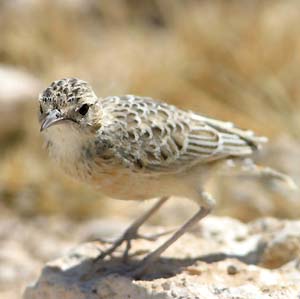
Spike-heeled Lark (juvenal) Etosha NP |
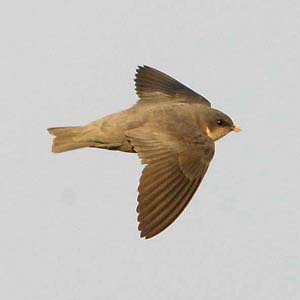
Plain Martin near Brandvlei, South Africa |
| Plain Martin Riparia paludicola | Seen around water in the interior and widely recorded from Brandvlei to the Caprivi Strip | |
| Banded Martin Riparia cincta | One bird was seen over the Okavango Riverduring a boat ride | |
| Wire-tailed Swallow Hirundo smithii | A few were foraging along the Okavango River in Botswana | |
| Lesser Striped-Swallow Hirundo abyssinica | The most common swallow over the Okavango River. We also found some building mud nests stuck to the 'giant baobab' in Mahango Reserve. It seemed quite early to start nestingbut they were at it . . . | |
| Rock Martin Hirundo fuligula | The most common swallow throughout the trip. It was recorded on 25 of 29 days (usually 10-50/day). It was missing only from the Okavango River in Botswana; it is decidedly a dry-country swallow | |
| Fiscal Shrike Lanius collaris | Common and widespread: recorded on 19 of 29 days in open country. The interior birds (race subcoronatus) have white superciliary stripes | |
| Magpie Shrike Corvinella melanoleuca | Small parties in the Caprivi Strip and in open cut-over woods driving into Drotsky's Camp | |
| White-crowned Shrike Eurocephalus anguitimens * | NE | A few in eastern half of Etosha NP (including Halali Camp) with a few others in Mahango Game Reserve |

Fiscal Shrike Augrabies Falls NP |

White-crowned Shrike Halali Camp, Etosha NP |
| Brubru Nilaus afer | Patchily encountered in open woodland: Augrabies Falls NP; some spots in Etosha NP; and with mixed flock in Caprivi Strip woods | |
| Black-backed Puffback Dryoscopus cubla | A pair were with a mixed flock in deciduous Caprivi Strip woods; a few more were in Waterberg NP | |
| Black-crowned Tchagra Tchagra senegala | Singles daily in Caprivi Strip | |
| Brown-crowned Tchagra Tchagra australis | The more widespread tchagra in n. Namibia (Etosha to Waterberg) | |
| Swamp (Gabon) Boubou Laniarius bicolor * | A few daily in riverine scrub along Okavango River from Nkwaza Camp to Drotsky's Camp | |
| Southern Boubou Laniarius ferrugineus * | E | Pair seen at close quarters in vegetation at the entrance to Boulders Bay; thereafter only heard along the coast (Cape of Good Hope to Lamberts Bay) |
| Crimson-breasted Gonolek Laniarius atrococcineus * | NE | This very colorful bush-shrike was rather tame and obliging in thickets around water at KGNP; in Etosha NP; at Roy's Camp; and in the Xaro Camp woods |
| Bokmakierie Telophorus zeylonus | NE | A widespread interior bush-shrike that was elusive and more often heard than seen. Observed or heard from West Coast NP through Brandvlei and north through Namibia to Spitzkoppe & Etosha |
| Sulphur-breasted Bush-Shrike Telophorus sulfureopectus | One glimpsedin woods at Xaro Camp on Okavango River | |
| White Helmet-Shrike Prionops plumatus | Small parties seen twice: Etosha NP and in Caprivi Strip woods | |
| Retz's Helmetshrike Prionops retzii * | A pair in woods at Xaro Camp were an unexpected treat | |
| Fork-tailed Drongo Dicrurus adsimilis | Common and widespread from KGNP north (15-80/day in Namibia & Botswana) | |
| House Crow Corvus splendens [I] | This introduced species was at the Cape Town airport | |
| Cape Crow (Cape Rook) Corvus capensis | This icterid with the odd Rook-like bill and crow-like call was patchily distributed inland from Calvinia karoo to KGNP and Etosha NP to Caprivi Strip | |
| Pied Crow Corvus albus | Common and widespread throughout except s. Namibia (too dry) and Okavango Delta (too humid) | |
| White-necked Raven Corvus albicollis | A few seen time to time in the Cape vicinity and in verdant karoo inland to Calvinia |
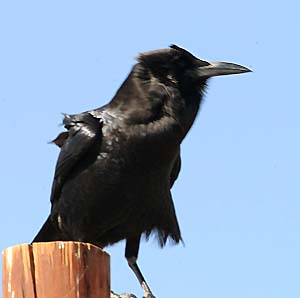
Cape Crow Kalahari-Gemsbok NP |

White-necked Raven south of Brandvlei, South Africa |
| Cape Batis Batis capensis * | E | A few in woods at Kirstenbosch Gardens and north to West Coast NP |
| Chinspot Batis Batis molitor | A pair with mixed feeding flock in Brachystegia woods in Caprivi Strip | |
| Pririt Batis Batis pririt * | NE | The widespread interior batis in thornscrub from Brandvlei & Augrabies Falls NP to KGNP through Etosha and Waterberg parks |
| White-tailed Shrike Lanioturdus torquatus * | NE | This fabulous endemic was in dry scrub at Spitzkoppe and Erongo Wilderness Lodge. Recent biochemical data (Beresford et al. 2005) show it belongs with the batises taxonomically |
| [African Paradise-Flycatcher Terpsiphone viridis | Rita and Richard had single on two days in Caprivi Strip and Xaro Camp (missed by Don). These were presumably early spring migrants] | |
| Southern Black Tit Parus niger * | NE | A few in Caprivi Strip, mostly with mixed flocks in dry deciduous woods |
| Carp's Tit Parus carpi * | NE | A pair in eastern Etosha NP and a pair at Waterberg NP were the only ones encountered |
| Ashy Tit Parus cinerascens | A pair in scrub at Daan Viljoen Reserve outside Windhoek was it | |
| Southern Penduline-Tit Anthoscopus minutus * | NE | A pair with a mixed flock in thornscrub in western Etosha NP represented a new family for Rita;and a new family representative photographed for Don. This is perhaps the tiniest bird in southern Africa |
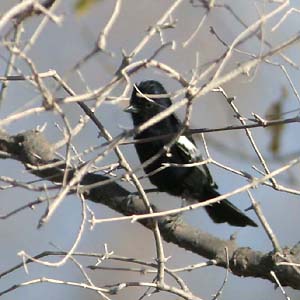
Carp's Tit Etosha NP |
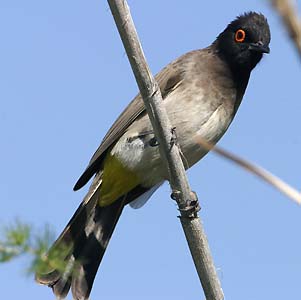
Black-fronted (Red-eyed) Bulbul Augrabies Falls NP |
| Dark-capped (Common, Black-eyed) Bulbul Pycnonotus barbatus | This was the common roadside bulbul in the Caprivi Strip and Okavango Delta | |
| Black-fronted (Red-eyed) Bulbul Pycnonotus nigricans | NE | This was the common bulbul of thornveld in the interior from Brandvlei through KGNP to Etosha; it was seen every day in this habitat (often 50+/day) |
| Cape Bulbul Pycnonotus capensis * | E | The common coastal bulbul from Cape Town to Lamberts Bay |
| Sombre Greenbul Andropadus importunus | Four in thick understory at Kirstenbosch Gardens near Cape Town | |
| Yellow-bellied Greenbul Chlorocichla flaviventris | Regular in riverine thickets along Okavango River (N'kwazi Camp to Drotsky's) | |
| Terrestrial Brownbul Phyllastrephus terrestris | Two at Drotsky's Camp in thick woods at Okavango River edge | |
| Cape Rock-Thrush Monticola rupestris * | E | We looked hard for this endemic. Rita saw a male along Walker Bay. Don saw his at Jonken Dam near Noordhoek |
| Short-toed Rock-Thrush Monticola brevipes * | NE | One male was scoped as it sat on Avis Dam itself (near Windhoek); Richard saw a female at Spitzkoppe |
| Groundscraper Thrush Psophocichla litsipsirupa | A tame pair at Namutoni Camp in Etosha fed right at our feet; a few others were seen in Etosha and in the Caprvi Strip | |
| Kurrichane Thrush Turdus libonyanus | A few of this standard Turdus thrush were in the deciduous woods around Rundu and into the Caprivi Strip | |
| Olive Thrush Turdus olivaceus | Easily seen at Kirstenbosch Gardens near Cape Town | |
| Karoo Thrush Turdus smithi * | E | This is a recent split from the preceding species. We saw it at the Brandvlei Hotel; in Augrabies Falls NP; and at Canyon Lodge in s. Namibia |
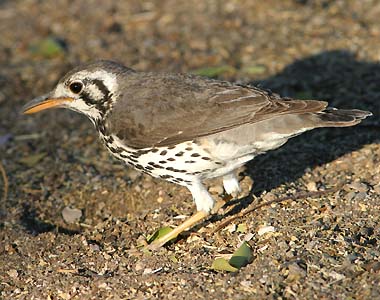
Groundscraper Thrush Namutoni Camp, Etosha NP |
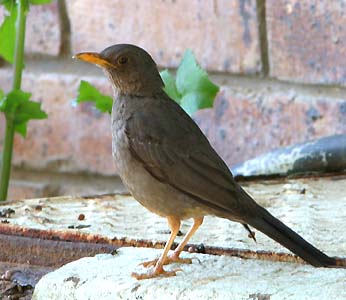
Karoo Thrush Brandveli, South Africa |
| Rattling Cisticola Cisticola chinianus | A couple were at the car-park at Avis Dam in Windhoek; it was then encountered regularly in the Caprivi Strip woods and at Mahango Reserve | |
| Gray Cisticola Cisticola rufilatus | Less common than Rattling in the understory brush of Caprivi Strip woodlands but we did flush a couple for decent views | |
| Red-headed (Gray-backed) Cisticola Cisticola subruficapillus * | NE | Our best views were in the fynbos at Jonker Dam near Noordhoek; a few others were at inland stops between Lamberts Bay and Brandvlei |
| Chirping Cisticola Cisticola pipiens * | This is a papyrus specialist heard daily along the Okavango River. We used tapes one morning to call up several for nice views from the boat | |
| Tinkling (Levaillant's) Cisticola Cisticola tinniens | Our only ones (4) were at Tienie Versveld Wildflower Reserve | |
| Piping (Nedicky) Cisticola Cisticola fulvicapillus | Dingy plain-colored cisticolas at Jonker Dam and then much later in Caprivi Strip woods werethis species. These widely separated populations were of different subspecies | |
| [Zitting Cisticola Cisticola juncidis | Richard had one at Mahango Reserve; Rita and I missed it ] | |
| Desert Cisticola Cisticola aridulus | A few were seen daily in arid grasslands at Etosha NP | |
| Cloud Cisticola Cisticola textrix * | More than a half-dozen were doing spectacular 'skyscraping' song flights over Tienie Versveld Wildflower Reserve. There is talk of splitting this coastal race |

Red-headed Cisticola Jonker Dam nr Noordhoek, South Africa |
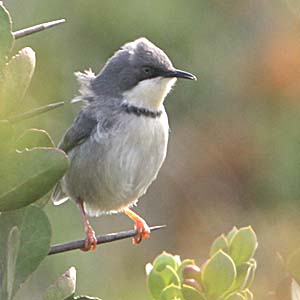
Bar-throated Apalis West Coast NP, South Africa |
| Tawny-flanked Prinia Prinia subflava | A couple in riverside reeds along the Okavango River | |
| Black-chested Prinia Prinia flavicans | NE | This was the common interior arid-country prinia from Brandvlei and Augrabies Falls through KGNP and s. Nambia to Etosha NP (5-15/day). As it was winter most were in basic plumage and lacked the black chest band of breeding males |
| Spotted (Karoo) Prinia Prinia maculosa * | E | This was the coastal prinia seen from Boulders Bay to West Coast NP; it did range into the more succulentkaroo but dropped out and was replaced by the preceding species around Brandvlei. Given this distribution the name Spotted Prinia is much better (in my view) than Karoo Prinia. It seemed shier than Black-chested Prinia |
| Namaqua Warbler Phragmacia substriata * | E | We worked and worked with a tape to get views of a few in Phragmites reeds at Augrabies Falls NP. The next day I coaxed one out for photos by prolonged 'pishing.' This isa very 'missable' endemic so we were quite pleased with these successes |
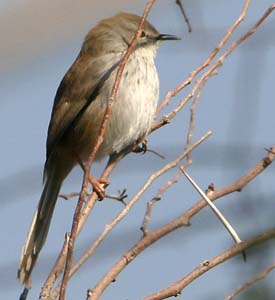
Namaqua Warbler Augrabies Falls NP |
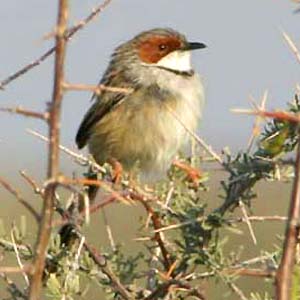
Rufous-eared Warbler near Brandvlei, South Africa |
| Rufous-eared Warbler Malcorus pectoralis * | E | Spottily distributed inkaroo and scrub: a half-dozen daily around Brandvlei but seen on only one day in KGNP; two final birds were in thornveld near Okajkuejo Camp in Etosha NP |
| Bar-throated Apalis Apalis thoracica | Our only observations were in coastal scrub at West Coast NP | |
| Yellow-breasted Apalis Apalis flavida | A couple in scrub at the east end of Etosha NP; more were in mixed flocks in Brachystegia woodland in the Caprivi Strip | |
| Gray-backed Camaroptera Camaroptera brevicaudata | Rather scarce in Etosha NP and Caprivi Strip (just 1-2 birds most days from Halali Camp to N'kwazi Camp) but then rather common in riverine woods on the Okavango in Botswana | |
| Barred Camaroptera Calamonastes fasciolatus * | NE | Don saw one bird in thornscrub at the east end of Etosha NP. Rita & Richard missed that one but caught up with two in a mixed flock on the trip's final day at Daan Viljoen Reserve near Windhoek |
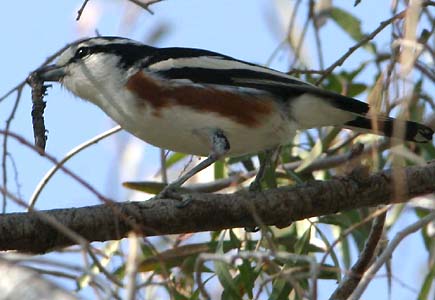
Brubru (with prey) Augrabies Falls NP |

Gray-backed Camaroptera N'kwazi Camp nr Rundu |
| African Bush Warbler Bradypterus baboecala | The only one seen was in reeds along a dry streambed near Brandvlei; Richard heard others in Cape Town vicinity | |
| Knysna Scrub-Warbler Bradypterus sylvaticus * | E/
VU |
Careful work with tape and lots of patience finally yielded superb views of a pair in streamside thickets on the back side of Table Mountain near Cape Town |
| Greater Swamp-Warbler Acrocephalus rufescens | One seen (several more heard) in papyrus reeds along Okavango River | |
| Lesser Swamp-Warbler Acrocephalus gracilirostris | A shy bird of reeds we had glimpses at Strandfontein and again at N'kwazi Camp on Kavango River; Richard heard more here and there | |
| Yellow-bellied Eremomela Eremomela icteropygialis | Patchily encountered in interior scrub: Brandvlei and Augrabies Falls to Etosha NP and Mahango Reserve | |
| Yellow-rumped (Karoo) Eremomela Eremomela gregalis * | E | We had one party of six in karoo near Brandvlei and that was it |
| Burnt-necked Eremomela Eremomela usticollis * | Rita and Don had a small group (4) inside Namutoni Camp in Etosha NP; another small group was in thornscrub at Daan Viljoen Reserve west of Windhoek on our final morning | |
| Victorin's Scrub-Warbler Cryptillas victorini * | E | Tape at a little streamside gulley brought in a very vocal male along the shores of Walker Bay; views however were very brief and fleeting |
| Rockrunner Achaetops pycnopygius * | NE | This fabulous rock-loving warbler— which recalls grasswrens of Australia and acts like an American CanyonWren — was well seen at Avis Dam in Windhoek and again in rock jumble at the base of the Waterberg Plateau |
| Cape Grassbird Sphenoeacus afer * | E | This cool and retiring endemicwas seen well at Jonker Dam near Noordhoek. It is a vocal bird and was heard at other Cape Town sites and north to West Coast NP. Recent biochemical evidence (Beresford et al. 2005) shows that this endemic groups with the preceding two species and the crombecs to form a unique 'African warbler clade' that likely warrant family status |
| Long-billed Crombec Sylvietta rufescens | A regular bird of thornveld in the interior but never common. It was seen on 10 different days from scrub inland of Lamberts Bay through Etosha to Waterberg NP (but usually just 2-4/day) |
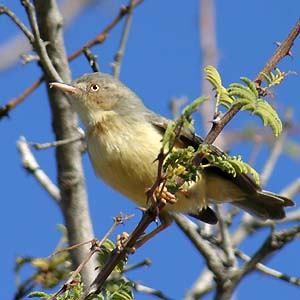
Burnt-necked Eremomela Daan Viljoen Game Reserve |
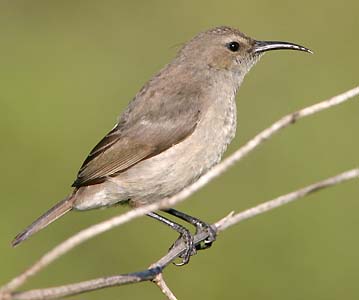
Southern Double-collared Sunbird (female) south of Calvinia, South Africa |
| Layard's Parisoma Parisoma layardi * | E | A few in karoo south of Calvinia (especially at an overlook as we climbed an escarpment) and two more in scrub at the base of Spitzkoppe. This genus (Parisoma) is now thought to be in the Babbler family; both this and the next species are usually called"Warblers" but this proves not to be the right family |
| Rufous-vented Parisoma Parisoma subcaeruleum | NE | Reasonable regular (2-4/day) in dry karoo and Kalahari scrub from Brandvlei to KGNP and throughout s. Namibia north to Etosha NP and in Waterberg NP (see preceding species re taxonomy) |
| Black-faced Babbler Turdoides melanops | NE | We stopped at Roy's Camp on the drive from Etosha to the Caprivi Strip because it is a stake-out for this specialty. Upon receiving permission to bird the grounds we promptly found a small group |
| Hartlaub's Babbler Turdoides hartlaubii * | This personable babbler was in riverside scrub on the Okavango from N'kwazi Camp near Rundu to Xaro Camp in Botswana | |
| Southern Pied Babbler Turdoides bicolor * | NE | A party of 8 or so was in a mixed species flock in open woods along the dry Khan River bed near Erongo Mts. |
| Arrow-marked Babbler Turdoides jardineii | Three were seen at Drotsky's Camp. All these Turdoides babblers (3 preceding and one following species) seem to be very local in distribution | |
| Bare-cheeked Babbler Turdoides gymnogenys * | NE | A family group of four huddled together in mid-afternoon at Halali Camp in central Etosha NP. This endemic is well-known from this spot but we never saw them there again despite another evening and morning in residence here |
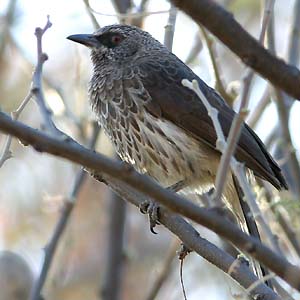
Hartlaub's Babbler N'kwazi Camp nr Rundu |
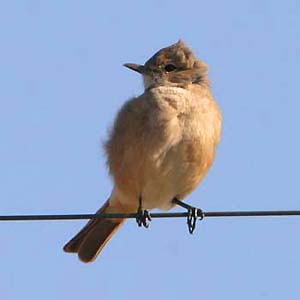
Chat Flycatcher south of Brandvlei, South African |
| Pale Flycatcher Bradornis pallidus | A very few seen in open woods near Rundu and east into Caprivi Strip | |
| Chat Flycatcher Bradornis infuscatus * | NE | Rather conspicuous in karoo habitat south of Brandvlei (often on telephone lines); a couple more at Spitzkoppe |
| Mariqua Flycatcher Bradornis mariquensis * | NE | The common dry country flycatcher from KGNP north. Perhaps most commin in the Kalahari (up to 25/day) but regular in Etosha NP (up to 10/day) and along Okavango River(1-2/day) but not seen in the Caprivi Strip |
| Fiscal Flycatcher Sigelus silens | E | A few scattered individuals: nearWalker Bay, West Coast NP, and Augrabies Falls NP |
| African Dusky Flycatcher Muscicapa adusta | Common at mid-story in woods of Constancia greenbelt on 'back' side of Table Mountain | |
| Gray Tit-Flycatcher Myioparus plumbeus | One in woods behind Xaro Camp on Okavango | |
| Fairy Flycatcher Stenostira scita * | E | One foraging among the cliffs at Paleisheuwel Canyon (well inland from Lamberts Bay). This tiny flycatcher is now assigned to the newly defined family Stenostridiae (Beresford etal. 2005), as are a few other African and Asian enigmatic flycatchers |

Fiscal Flycatcher Augrabies Falls NP |
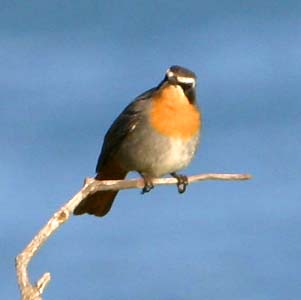
Cape Robin-Chat Walker Bay, South Africa |
| Cape Robin-Chat Cossypha caffra | Common is scrub along the coast and inland to Brandvlei and Augrabies Falls NP | |
| White-browed Robin-Chat Cossypha heuglini | The regular robin-chat in the Caprivi Strip woods; one sang loudly in the morning and evening on the Xaro Camp grounds | |
| Red-backed Scrub-Robin Cercotrichas leucophrys | A few in scrub at Mahango Reserve and Waterberg NP | |
| Kalahari Scrub-Robin Cercotrichas paena | NE | We had one in the Kalahari of KGNP; others were at Anib Lodge and in Etosha NP |
| Karoo Scrub-Robin Cercotrichas coryphoeus * | E | Common in the more succulent karoo between Calvinia and Brandvlei (20/day) but becoming scarcer as it became more arid at Brandvlei |
| Herero Chat Namibornis herero * | NE | Two pairs were found at Spitzkoppe.This was a major coup since the species is easily missed. One of the birds was wearing a band: clearly there is a research project underway |
| African Stonechat Saxicola torquata | Daily in the karoo south of Brandvlei; Richard had one in Botswana | |
| Mountain Wheatear Oenanthe monticola | NE | This is a chat of rocky country and cliffs: birds at Augrabies Falls NP; Fish River Canyon and Canyon Lodge;and around Spitzkoppe and Erongo Wilderness Lodge |
| Capped Wheatear Oenanthe pileata | Fairly common in grasslands near the coast (mostly south and inland of Lamberts Bay) | |
| Sickle-winged Chat Cercomela sinuata * | E | The most difficult of theCercomela chats of western South Africa: we saw only one pair south of Brandvlei |
| Karoo Chat Cercomela schlegelii * | E | Regular in small numbers around Brandvlei |
| Tractrac Chat Cercomela tractrac * | NE | The most common of the karoochats (20+/day around Brandvlei); also seen in the arid plains around Spitzoppe (very pale birds here) |
| Familiar Chat Cercomela familiaris | Widespread and locally common:several on the coast around Cape Town; more at Augrabies Falls NP and KGNP; scattered birds in s. Namibia and again at Waterberg NP and near Windhoek | |
| Southern Ant-eating Chat Myrmecocichla formicivora | E | Regular in dryscrub: arid karoo around Brandvlei; KGNP; and in Etosha NP |
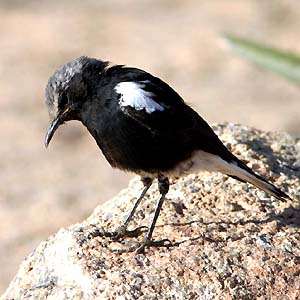
Mountain Chat Spitzkoppe |

Familiar Chat Augrabies Falls NP |
| African Pied Wagtail Motacilla aguimp | Only a few seen: one in Augrabies Falls NP and then pairs at Mahango Reserve and Xaro Camp | |
| Cape Wagtail Motacilla capensis | Regularly seen around the Cape and along the coast with only a few inland to Augrabies Falls; four more much later at Avis Dam in Windhoek | |
| Orange-throated Longclaw Macronyx capensis | E | Our only ones were at Tienie Versveld Wildflower Reserve (~8) |
| African Pipit Anthus cinnamomeus | Not many: a few at NieuwoutvilleWildflower Reserve and then a couple at Mahango Game Reserve and along the drive into Drotsky's Camp in Botswana | |
| Plain-backed/Buffy Pipit Anthus leucophrys/vaalensis | A single pipit foraging in a field and seen from a boat on the Okavango River was one of these species. They are extremely difficult to separate (and especially so from a boat no matter how still you try to sit) | |
| Wood Pipit Anthus nyassae | One was flushed from the grassy understory to Brachystegia woods near Rundu; it perched in a tree for nice scope views | |
| Orange-breasted Sunbird Anthobaphes violacea * | E | Locally common in fynbos and planted exotics around Cape Town |
| Malachite Sunbird Nectarinia famosa | Scattered birds in fynbos around Cape Town (and at Kirstenbosch Gardens) | |
| Southern Double-coll. Sunbird Cinnyris chalybea * | E | The most widespreadof the endemic sunbirds: seen daily around Cape Town (including the suburbs and gardens) and inland through the more succulent karoo to near Calvinia |
| White-bellied Sunbird Cinnyris talatala | One in srubby savanna in Etosha was it. This had been the common sunbird during our July visit to Kruger NP in eastern South Africa several years earlier | |
| Dusky Sunbird Cinnyris fusca * | NE | This was the common dry-country sunbird from Augrabies Falls NP to Fish River Canyon to Etosha and Windhoek (but not seen in KGNP) |
| Marico Sunbird Cinnyris mariquensis | A very few in Etosha NP and then a few more in Caprivi Strip and another at Daan Viljoen Reserve | |
| Purple-banded Sunbird Cinnyris bifasciata | Two in woods behind Xaro Camp on Okavango |
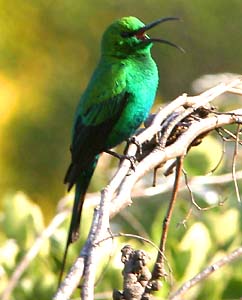
Malachite Sunbird Jonker Dam nr Noordhoek, South Africa |
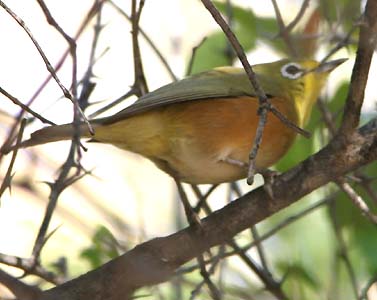
Orange River White-eye Augrabies Falls NP |
| African Yellow White-eye Zosterops senegalensis | Common in wooded patches on the Okavango (especially at Drotsky's) | |
| Cape White-eye Zosterops virens | E | Rather common around Cape Town and north to Lambert Bay & environs inland |
| Orange River White-eye Zosterops pallidus * | E | This is a recent split from the preceding species. It is quite distinctive with apricot-colored flanks and somewhat different calls. It was common in Augrabies Falls NP and at Fish River Canyon vicinity (Canyon Lodge) |
| Cape Sugarbird Promerops cafer * | E | This engaging endemic was surprisingly common in fynbos and flowering gardens around Cape Town (east to Walker Bay and north to inland of Lamberts Bay) |
| Pale-winged Starling Onychognathus nabouroup * | NE | The common starling of rocky cliffs inland from Augrabies Falls NP to Fish River Canyon and Spitzkoppe |
| Red-winged Starling Onychognathus morio | Common around Cape Town: in the cities and out to Cape of Good Hope | |
| Cape Glossy-Starling Lamprotornis nitens | NE | Widespread inland: from KGNP through Namibia all the way up to Caprivi Strip |
| Burchell's Glossy-Starling Lamprotornis australis | NE | We first ran intothese along the dry Khan River; scattered birds were in Caprivi Strip and throughout Okavango Delta |
| Meve's Glossy-Starling Lamprotornis mevesii | NE | A few in Caprivi Strip and Mahango Reserve |
| Violet-backed Starling Cinnyricinclus leucogaster | We were surprised to find small parties of males & females in woods in Caprivi Strip and down into Botswana. They may be resident here but populations farther south are migratory and absent in winter | |
| African Pied Starling Spreo bicolor * | E | Locally common at West Coast NP and along the drive inland from Lamberts Bay. A few more at Augrabies Falls NP |
| Wattled Starling Creatophora cinerea | Several small flocks along the coast from West Coast NP to Lamberts Bay; also seen in KGNP (2); in w.Etosha; and in Caprivi Strip | |
| European Starling Sturnus vulgaris [I] | This introduced bird was common around Cape Town | |
| Red-billed Oxpecker Buphagus erythrorhynchus | Oxpeckers were riding cows near Rundu; riding antelope in Mahango Reserve; and were in the woods behind Xaro Camp |
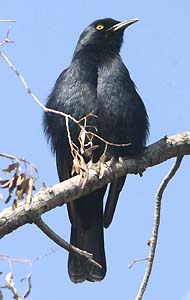
Pale-winged Starling Augrabies Falls NP |
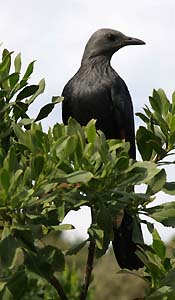
Red-winged Starling Cape of Good Hope NP |
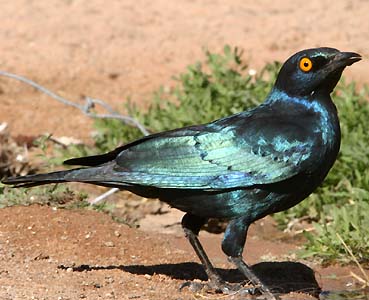
Cape Glossy-Starling Kalahari-Gemsbok NP |
| House Sparrow Passer domesticus [I] | A non-native species introduced commonly in interior towns & cities throughout (but not Caprivi Strip or Okavango Dela) | |
| Rufous Sparrow Passer motitensis | NE | A few daily in Etosha NP and vicinity |
| Cape Sparrow (Mossie) Passer melanurus | NE | Common in Cape Town and then inland to Windhoek |
| Southern Gray-headed Sparrow Passer diffusus | NE | Regular at AugrabiesFalls NP, in KGNP, and in Etosha NP |
| Red-billed Buffalo Weaver Bubalornis niger | A half-dozen were part of a mixed flock in open woods along dry Khan River; others were at Namutoni in Etosha; in Mahango Reserve; and at Xaro Camp | |
| Scaly Weaver Sporopipes squamifrons * | NE | Is this a weaver or a finch? Dickinson (2003) still lists it as a weaver but it is very finch-like. Small parties were commonly seen in KGNP; at Fish River Canyon; and inEtosha NP |
| White-browed Sparrow-weaver Plocepasser mahali | Common inland from Upington and KGNP through Etosha and Caprivi Strip | |
| Social Weaver Philetairus socius * | E | Common and very conspicuous (due to their huge nests on dead trees and telephone poles) from KGNP and vicinity through s. Namibia to Etosha NP |
| Cape Weaver Ploceus capensis * | E | Local but seen daily from Cape Town vicinity to Nieuwoutville Wildflower Reserve south of Calvinia. Males were nest-building at latter site |
| Holub's Golden Weaver Ploceus xanthops | A half-dozen seen between 3 sites on the Okavango River | |
| Southern Masked-Weaver Ploceus velatus | Common and widespread throughout much of the trip. Birds were nest-building at Bloubergstrand pond on the coast; they were numerous daily from Augrabies Falls to KGNP to Etosha and Waterberg. Also on the Okavango River and missing only from the most arid parts of Namibia | |
| Red-billed Quelea Quelea quelea | Not very common: a few in KGNP and again in Etosha NP in grasslands | |
| Red Bishop Euplectes orix | A male was among 20+ bishops roosting in reeds at Boubergstrand pond on the coast | |
| Yellow Bishop Bishop Euplectes capensis | Scattered individuals were on or near the coast from Walker Bay to Lamberts Bay; a couple were gaining full adult male garb |

Cape Sparrow Cape Town |
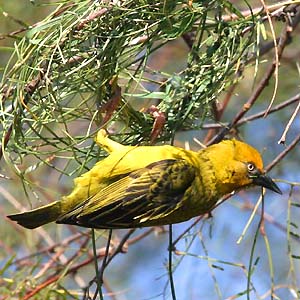
Cape Weaver [male nest-building] Nieuwoutville Wildflower Reserve |
| Green-winged Pytilia Pytilia melba | Just 1-2 were at dry country spots (e.g. KGNP or Etosha) but regularly recorded in scrub on Caprivi Strip and in Botswana | |
| Brown Firefinch Lagonosticta nitidula * | A flock of ~25 was in the woods behind Xaro Camp | |
| Red-billed Firefinch Lagonosticta senegala | A mixed flock with the next species was in the Caprivi Strip; one more seen at Xaro Camp | |
| Jameson's Firefinch Lagonosticta rhodopareia | A mixed flock with the preceding species was in the Caprivi Strip | |
| Blue-breasted Cordonblue Uraeginthus angolensis | These became regular in eastern Etosha NP and were seen daily through Caprivi Strip and into Botswana | |
| Violet-eared Waxbill Granatina granatina * | NE | This elegant dry-country specialty was seen spottily from KGNP (just 2) to Windhoek to Spitzkoppe to Etosha NP and Caprivi Strip (not more than 4/day anywhere) |
| Swee Waxbill Estrilda melanotis * | E | A flock of 9 was feeding on a lawn in Kirstenbosch Gardens late in the day; lovely birds and a special treat |
| Common Waxbill Estrilda astrild | Flocks patchily distributed from Cape Town vicinity to Augrabies Falls NP; the only others were in Caprivi Strip | |
| Black-cheeked Waxbill Estrilda erythronotos * | Another classy dry-country specialty seen in small numbers: KGNP (2); Avis Dam in Windhoek; Spitzkoppe; and Etosha NP | |
| Cut-throat Amadina fasciata | Five were in a mixed flock of ground-feeding waxbills on the edge of a little village in the Caprivi Strip | |
| Shaft-tailed Whydah Vidua regia * | NE | One or two non-breeding birds were among flocks of quelea in KGNP |
| Pin-tailed Whydah Vidua macroura | A few in winter drab were in Etosha NP to Caprivi Strip | |
| [Chaffinch Fringilla coelebs [I] | Rita had one in the motel garden at Noordhoek. They are introduced to the Cape Town vicinity] |
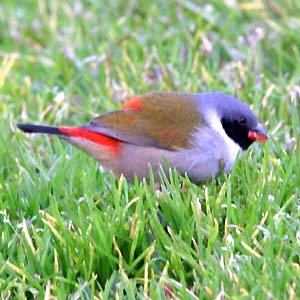
Swee Waxbill Kirsternbosch Gardens, Cape Town |
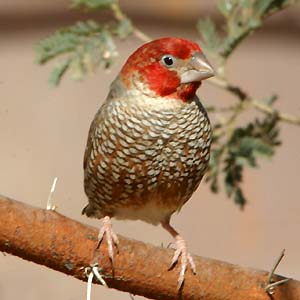
Red-headed Finch Kahari-Gemsbok NP |
| Red-headed Finch Amadina erythrocephala * | NE | Common in flocks in KGNP (up to 250/day); smaller flocks were regular in Etosha NP and again at Waterberg NP |
| Cape Canary Serinus canicollis | A few around Cape Town and along the coast | |
| Black-throated Canary Serinus atrogularis | Some came to waterholes at KGNP and Etosha; a few more were around Spitzkoppe | |
| Yellow-fronted Canary Serinus mozambicus | The regular canary in deciduous woods of Caprivi Strip | |
| Yellow Canary Serinus flaviventris | NE | Common inland in karoo around Brandvlei and in KGNP; a couple more near Windhoek |
| White-throated Canary Serinus albogularis * | NE | Rather common daily (6-40/day) in karoo around Brandvlei and then again in dry country from Fish River Canyon to Windhoek |
| Streaky-headed Seedeater Serinus gularis * | A pair was studied in Paleisheuwel Canyon during our first visit there | |
| Protea Canary Serinus leucopterus * | E | One of these local endemics was feeding quietly on a flowering bush in Paleisheuwel Canyon during our second visit there |
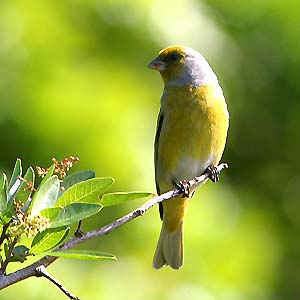
Cape Canary Simonstown, South Africa |
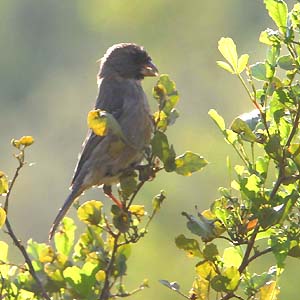
Protea Canary Paleisheuwel Canyon, South Africa |
| Cape Siskin Pseudochloroptila totta * | E | A handful were seen in flight and on distant perches at Jonker Dam near Noordhoek |
| Lark-like Bunting Emberiza impetuani * | NE | This was an abundant bird in the karoo around Brandvlei (100+/day); more were in Augrabies Falls NP and from Fish River Canyon to Windhoek |
| Cinnamon-breasted Bunting Emberiza tahapisi | One at Avis Dam in Windhoek | |
| Cape Bunting Emberiza capensis | Common in fynbos east of Cape Town and then again in karoo around Brandvlei; a few more were in very arid country at Spitzkoppe and Erongo Wilderness Lodge | |
| Golden-breasted Bunting Emberiza flaviventris | A few daily in Etosha NP to the Caprivi Strip and at Waterberg NP |
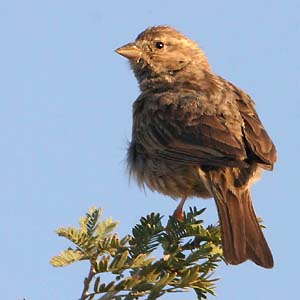
Lark-like Bunting Augrabies Falls NP |
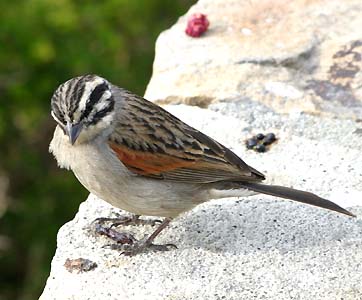
Cape Bunting Cape of Good Hope NP |
|
|
|
|
|
|
|
|
|
|
|
|
|
|
PHOTOS: All photos on this page are © 2005 Don Roberson; all rights reserved. Many other shots from this trip are scattered about this web site. Check particularly bird families, mammals, and herps listings.
Literature cited:
Beresford, P., F.K. Barker, P.G. Ryan, and T.M. Crowe. 2005. African endemics span the tree of songbirds (Passeri): molecular systematics of several evolutionary 'enigmas'. Proc. R. Soc. B 272: 849-858.TOPDickinson, E., ed. 2003. The Howard & Moore Complete Checklist of the Birds of the World. 3d ed. Princeton Univ. Press, Princeton, N.J.
Sinclair, I., P. Hockey, and W. Tarboton. 1993. Illustrated Guide to the Birds of Southern Africa. New Holland, London.
GO TO LIST OF BIRD FAMILIES OF THE WORLD